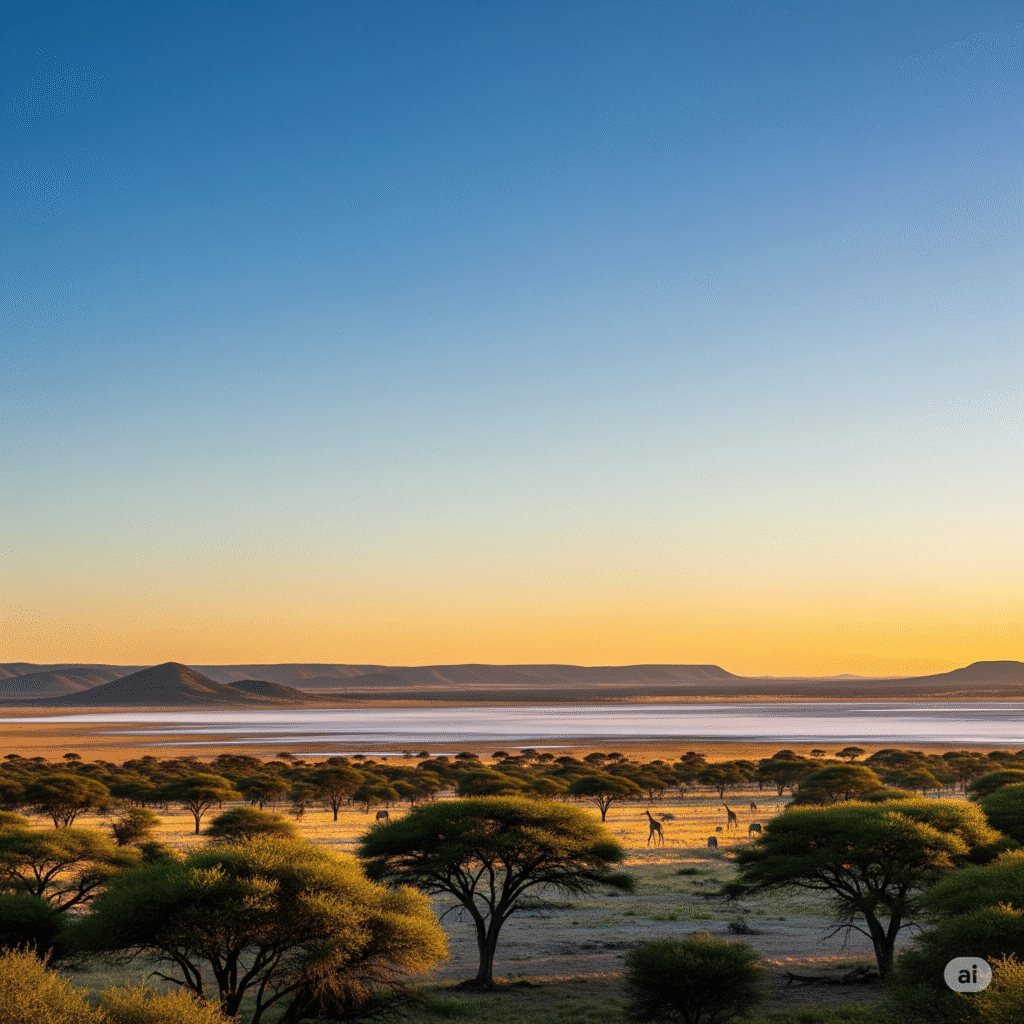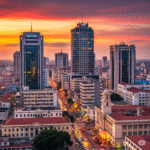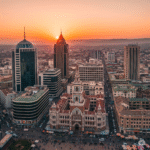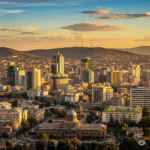
Etosha National Park: Your Ultimate Wildlife Safari Guide
Etosha National Park, a jewel of Namibian tourism and one of Africa’s premier wildlife destinations, promises an unforgettable safari adventure. This sprawling game reserve, encompassing shimmering salt pans, expansive grasslands, and dense bushland, teems with diverse wildlife. Witness majestic elephants, stealthy lions, graceful giraffes, endangered rhinos, and a dazzling array of bird species. This comprehensive guide will help you plan your perfect Etosha National Park adventure, maximizing your chances of incredible wildlife encounters.
- Address: Etosha National Park, Namibia
Planning Your Etosha Safari: Key Information
Essential Information for Your Visit
- Country: Namibia
Timezone
- GMT+2
Languages Spoken
- English
- Afrikaans
- German
- Various local languages (Oshiwambo, Herero)
Currency
- Namibian Dollar (NAD) – pegged 1:1 with South African Rand (ZAR)
Etosha’s Weather & Climate: A Seasonal Guide
- Dry Season (May-October): Expect cooler temperatures (10-25°C/50-77°F) and virtually no rain. This is the peak season and the best time for wildlife viewing, as animals concentrate around waterholes.
- Shoulder Season (April & November): Transitional periods with pleasant temperatures and occasional showers. A good compromise for fewer crowds and decent wildlife sightings.
- Wet Season (December-March): Hotter temperatures (25-40°C/77-104°F) and increased rainfall. The landscape transforms into a lush, green paradise, attracting abundant birdlife, including flamingos. However, wildlife viewing can be more challenging due to dispersed water sources.
Etosha National Park Overview: A Wildlife Paradise
Etosha National Park isn’t a city, but a vast, protected wilderness spanning over 22,000 square kilometers in northern Namibia. The iconic Etosha Pan, a colossal, shimmering salt pan, dominates the landscape. During the dry season, the pan is typically dry, compelling wildlife to gather at strategically located waterholes along its perimeter, creating prime game-viewing opportunities. The park also boasts a variety of habitats beyond the pan, including grasslands, savannah, mopani woodlands, and rugged dolomite hills. These diverse ecosystems support a stunning array of animals and birds. Etosha’s well-maintained roads, comfortable rest camps, and numerous waterholes make for a convenient and rewarding safari experience. This is a true testament to conservation, highlighting the magnificence and resilience of African wildlife in their natural environment.
The Best Time to Visit Etosha National Park
- Seasonal Pros and Cons: Wildlife Viewing Opportunities
- Dry Season (May-October):
- Pros: Unrivaled wildlife viewing, animals congregating at waterholes, sparse vegetation for optimal visibility, pleasant cooler temperatures.
- Cons: Dusty conditions possible, higher prices due to peak season demand, more crowded waterholes.
- Wet Season (December-March):
- Pros: Lush and vibrant landscapes, abundant birdlife, including migratory species, newborn animals (calving season), lower prices on accommodations.
- Cons: Wildlife viewing can be more challenging due to dispersed water sources and thicker vegetation, hotter and more humid temperatures, higher probability of rainfall.
- Dry Season (May-October):
Getting to Etosha & Visa Information
- Flights: International visitors typically fly into Hosea Kutako International Airport (WDH) in Windhoek. From Windhoek, you can rent a car for a self-drive safari (approx. 4-6 hour drive), or opt for a domestic flight to an airstrip closer to the park, such as Mokuti Lodge Airport.
- Trains: There’s no direct train service to Etosha National Park.
- Visa Details: Namibia offers visa-free entry for citizens of many countries. Always double-check the current visa requirements based on your nationality before your trip.
- Airport Transfers: Car rentals are easily accessible at Hosea Kutako International Airport. Numerous tour operators also provide transfers to Etosha, but a self-drive safari offers greater flexibility.
Etosha National Park: Fun Facts & History
The name “Etosha” originates from the Oshivambo language, meaning “Great White Place,” a fitting description for the vast salt pan at the heart of the park. The pan’s formation dates back millions of years, stemming from a large inland lake that gradually evaporated. Local folklore recounts a fierce tribal battle along the lake’s edge, where the tears of the defeated women formed the Etosha Pan.
Top 10 Things to See and Do in Etosha National Park
- Etosha Pan: Witness breathtaking mirages and observe massive wildlife gatherings, especially during the dry season.
- Address: Central Etosha National Park
- Okaukuejo Waterhole: One of Etosha’s most renowned and reliable waterholes, floodlit at night for captivating nocturnal wildlife viewing.
- Address: Okaukuejo Rest Camp, Etosha National Park
- Halali Waterhole: Another prime waterhole offering diverse wildlife sightings, conveniently located near Halali Rest Camp.
- Address: Halali Rest Camp, Etosha National Park
- Namutoni Fort: Immerse yourself in history at this beautifully restored fort, now a rest camp featuring a restaurant, swimming pool, and panoramic views.
- Address: Namutoni Rest Camp, Etosha National Park
- Fisher’s Pan: Explore a smaller pan on Etosha’s eastern side, famous for its incredible birdlife, particularly flamingos during the wet season.
- Address: Eastern Etosha National Park
- Okondeka: A renowned spot for observing prides of lions in their natural habitat.
- Address: Southern Etosha National Park
- Nebrowni Waterhole: Keep an eye out for the elusive black rhino at this popular waterhole.
- Address: Between Okaukuejo and Halali, Etosha National Park
- Andoni Plains: Scan the open grasslands on the northern edge of the pan, an excellent area for spotting cheetahs and other plains game.
- Address: Northern Etosha National Park
- Moringa Waterhole: Enjoy peaceful bird watching at this secluded waterhole.
- Address: near Halali Rest Camp, Etosha National Park
- Etosha Ecological Institute: Learn about the park’s invaluable research and conservation initiatives.
- Address: Near Namutoni Rest Camp, Etosha National Park
Discover Etosha’s Hidden Gems
- Olifantsrus Camp: Escape the crowds at this quieter rest camp in Etosha’s western section, boasting an elevated hide overlooking a waterhole.
- Address: Western Etosha National Park
- Groot Okevi: Explore a less-visited waterhole, a haven for diverse bird species.
- Address: Central Etosha National Park
- Etosha Lookout: Capture panoramic vistas of the Etosha Pan and the surrounding landscape from this scenic viewpoint.
- Address: along the main roads, Etosha National Park
Day Trips & Nearby Attractions near Etosha
- Waterberg Plateau Park: Hike through breathtaking scenery (Approx. 3-hour drive from Namutoni).
- Otjikoto Lake: Discover a lake which has world war history (Approx. 1-hour drive from Namutoni).
Etosha Photography: Picture-Perfect Spots
- Okaukuejo Waterhole at night: Capture stunning silhouettes of animals against the floodlit water for unforgettable memories.
- Etosha Pan at sunrise or sunset: Photograph the shimmering pan bathed in vibrant colors and captivating mirages.
- Namutoni Fort: Frame the historic architecture with wildlife in the foreground for unique and memorable shots.
- Wildlife close-ups: Get up close (safely!) to elephants, lions, giraffes, and other incredible animals with a zoom lens.
Etosha Safari: Where to Stay & Getting Around
Recommended Length of Stay in Etosha
- A stay of 3-4 days is ideal to explore the diverse regions of the park and increase your chances of witnessing a wide range of wildlife.
Top Accommodation Options in Etosha (by Budget)
- Budget
- Etosha Safari Camp: Situated outside the park near Andersson Gate, offering comfortable and affordable lodging.
- Address: C38, Etosha National Park
- Etosha Gateway Lodge: Located just outside the Anderson Gate, providing convenient access to the park.
- Address: D2695, Etosha National Park
- Etosha Safari Camp: Situated outside the park near Andersson Gate, offering comfortable and affordable lodging.
- Mid-Range
- Okaukuejo Rest Camp: Nestled inside the park, famous for its floodlit waterhole providing incredible nighttime wildlife viewing.
- Address: Etosha National Park
- Halali Rest Camp: Located within the park, featuring another excellent waterhole and a refreshing swimming pool.
- Address: Etosha National Park
- Namutoni Rest Camp: Situated inside the park, offering a historic fort setting and comfortable accommodations.
- Address: Etosha National Park
- Okaukuejo Rest Camp: Nestled inside the park, famous for its floodlit waterhole providing incredible nighttime wildlife viewing.
- Luxury
- Mokuti Etosha Lodge: Located just outside the Von Lindequist Gate, featuring lush gardens and upscale amenities.
- Address: Etosha National Park
- Onguma Tented Camp: An exclusive tented camp on Etosha’s eastern side, offering unparalleled luxury and personalized service.
- Address: Onguma Game Reserve, Etosha National Park
- Andersson’s at Ongava: A luxurious lodge on the Ongava Game Reserve, bordering Etosha, offering exceptional wildlife experiences.
- Address: Ongava Game Reserve, Etosha National Park
- Little Ongava: Offers privacy on the Ongava Game Reserve.
- Address: Ongava Game Reserve, Etosha National Park
- Mokuti Etosha Lodge: Located just outside the Von Lindequist Gate, featuring lush gardens and upscale amenities.
Getting Around Etosha National Park
- Public transport: Public transport options are extremely limited within the park.
- Taxis: Taxis are not available inside Etosha National Park.
- Self-drive: The most popular and practical way to explore Etosha is by renting a car, preferably a 4×4 for navigating certain areas and roads.
- Walking tips: Walking is only permitted in designated areas within the rest camps for safety reasons.
Preparing for Your Etosha Adventure
Etosha Packing Essentials
- Lightweight, neutral-colored clothing to blend in with the environment
- Wide-brimmed hat, sunglasses, and high SPF sunscreen to protect from the harsh sun
- Comfortable walking shoes for exploring rest camps and designated walking areas
- High-quality binoculars for enhanced wildlife viewing
- Camera with a zoom lens to capture stunning wildlife photographs
- Insect repellent to ward off mosquitoes and other insects
- First-aid kit containing essential medications and supplies
- Adapter for Namibian power outlets (Type D)
Useful Apps for Your Etosha Safari
- Maps.me: Download offline maps for reliable navigation within the park.
- Tracks4Africa: Access detailed maps specifically designed for overlanding in Southern Africa.
- SASurvival: Access essential first aid information and guidance.
Etosha Safety Tips & Cultural Etiquette
- Do’s: Respect wildlife by maintaining a safe distance, remain inside your vehicle unless in designated areas, adhere to all park regulations, and practice responsible tourism.
- Don’ts: Never feed animals, avoid littering, refrain from driving off-road, keep noise levels to a minimum, and avoid disturbing wildlife.
- Scams to avoid: Be cautious of unofficial guides or vendors offering services at inflated prices. Book accommodations and tours through reputable operators and lodges.
- Respectful behavior: Dress modestly when visiting local communities surrounding the park, request permission before taking photographs of people, and show respect for local customs and traditions.
Etosha: Food, Fun & Finds
Top Restaurants in Etosha National Park
- Okaukuejo Restaurant: Offers buffet-style meals and a la carte options with panoramic views of the iconic Okaukuejo waterhole.
- Description: Buffet and a la carte dining with waterhole views
- Address: Okaukuejo Rest Camp, Etosha National Park
- Halali Restaurant: Enjoy buffet and a la carte dining options in a relaxed setting near the Halali waterhole.
- Description: Buffet and a la carte dining
- Address: Halali Rest Camp, Etosha National Park
- Namutoni Restaurant: Dine in a unique atmosphere within the historic Namutoni Fort, offering a diverse menu.
- Description: Unique dining experience in historic fort
- Address: Namutoni Rest Camp, Etosha National Park
- Mokuti Etosha Lodge Restaurant: Indulge in a fine dining experience featuring Namibian and international cuisine in an elegant setting.
- Description: Fine dining with Namibian and international cuisine
- Address: Etosha National Park
Must-Try Namibian Dishes
- Biltong: Sample dried, cured meat, similar to beef jerky, a popular snack.
- Droëwors: Try dried sausage, often seasoned with coriander, a local favorite.
- Game meat: Sample kudu, oryx, or springbok steaks for a taste of Namibia.
Nightlife & Entertainment in Etosha
- Nightlife options are limited within the park. Some rest camps offer bars and restaurants where you can unwind and enjoy the evening under the stars.
Etosha Souvenirs & Local Crafts
- Crafts at rest camps: Purchase locally made crafts and souvenirs at the curio shops located within the rest camps, supporting local artisans.




